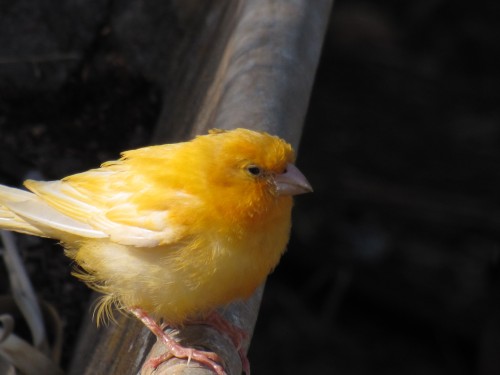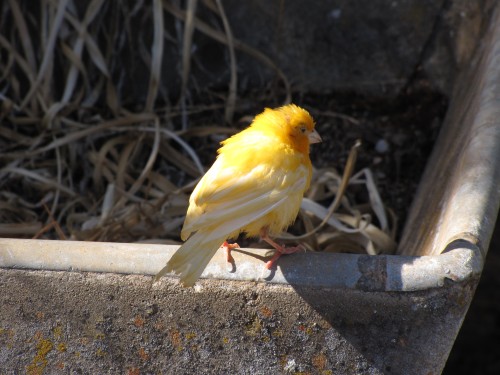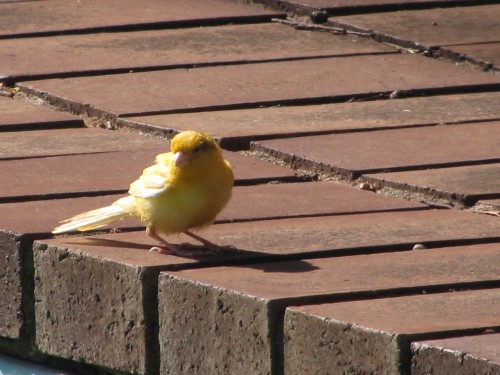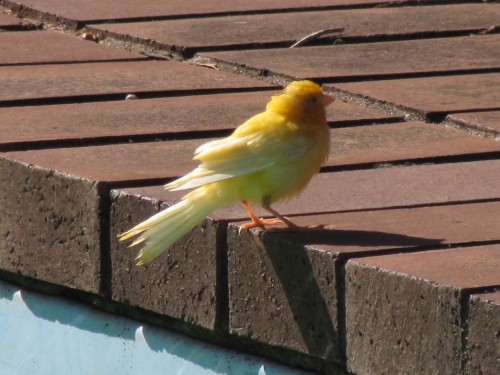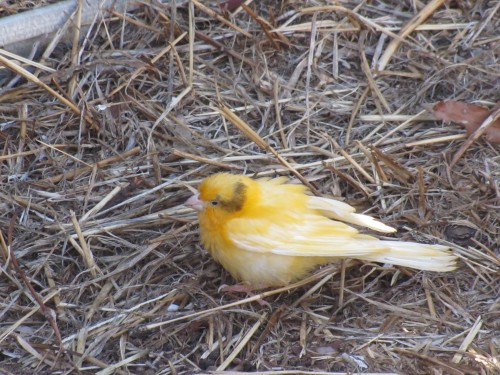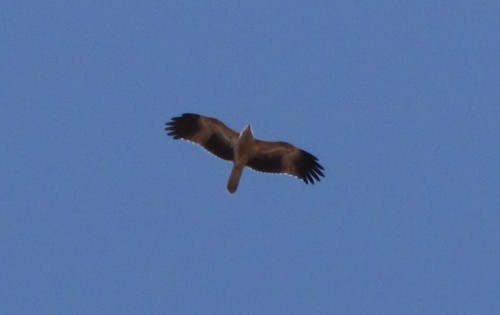Hello little Canary
A few weeks ago my attention was attracted to a strange looking bird on the rainwater tank. I raced inside to get my camera and was delighted to find that it had flown closer. I immediately identified it as a canary. It was now hopping around on the paving bricks around the swimming pool. I stealthily took some photos, zooming in to get closer to my subject.
When I carefully opened the safety gate into the pool area it stayed in place. It was obviously very used to people, or it was just naturally quite tame. I was able to approach slowly to within two metres, getting some good photos along the way. I actually tried to catch it seeing that it was not at all scared of me. On my last attempt it flew off over the fence and into the nearby trees. I haven’t seen it since. I presume it has either been taken by a bird of prey – we have many hawks and kites around here – or it found its way home next door. Both of our next-door neighbours have large aviaries and we often hear their canaries singing.
Canaries are not native to Australia. They are, however, a commonly kept cage bird. I remember having a canary when I was quite young. In fact, I think that it was actually my mother’s pet bird. She was convinced that it was a male bird – until it started laying eggs!
Many people are of the mistaken idea that the Canary Islands are named after the birds. These islands in the Atlantic Ocean, are a part of Spainish territory off the coast of Morocco. The bird known as a canary does exist on the islands, but they are named after the islands. The name Canary Islands literally means ‘the island of the dogs‘ and was named by the early Roman explorers. (See the Wikipedia article for more information.)
Further reading:
- Who has lost a canary? Another sighting of a canary in our garden some time ago.
Whistling Kite overhead at Pangarinda
Last week I wrote about the Tree Martins I saw and photographed at the Pangarinda Botanic Gardens near Wellington in South Australia. We were having an afternoon relaxing in the gardens to celebrate my wife’s birthday. You can read about the Tree Martins here.
While we were having a cuppa and some birthday cake with our friends I was taking note of all the birds I saw and heard. It was a lovely sunny day with a cooling breeze making the afternoon very pleasant indeed.
During the afternoon we saw and heard many birds, including plenty of New Holland Honeyeaters, both Red and Little Wattlebirds, Rainbow Bee-eaters, White-browed Babblers and even several Brown Quail. Go to the reading list at the end of this post for a link to the article about the quail.
While we were sitting at the picnic table having our afternoon cuppa a Whistling Kite soared overhead a number of times. I managed to get one reasonable photo, the one shown above. I still have yet to master the art of taking photos of birds in flight. The other shots are either too blurry, or too far away to be useful.
Whistling Kites are quite common along the Murray River in South Australia. The botanic gardens at Wellington are barely 500 metres from the river and possibly even closer to some of the reed-covered banks nearby, so I was not surprised to see one overhead. In fact, this species is common throughout most of mainland Australia where suitable habitat exists. Their preferred habitat includes open woodlands usually near water, along creeks, rivers, lakes and swamps where there are suitable nesting and roosting trees. They occasionally can be seen in Tasmania too.
Further reading:
- Tree Martins all a twitter
- Calling up a Brown Quail
- Birds and plants of the Pangarinda Arboretum (this was the early name for these gardens).
